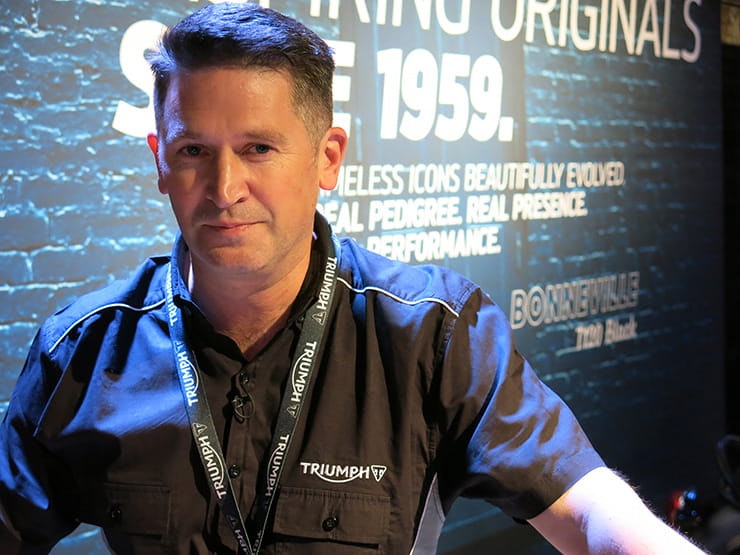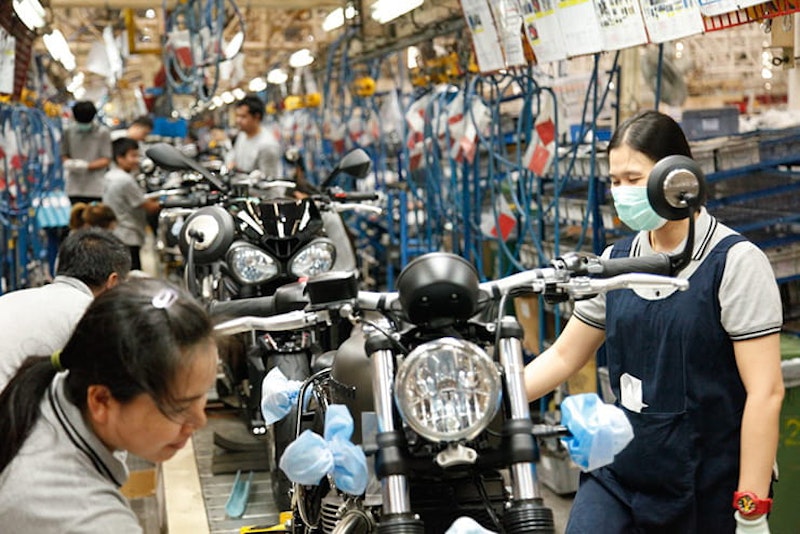Where was your Triumph motorcycle made?
By John Milbank
Consumer Editor of Bennetts BikeSocial
05.10.2017
Steve Sergent, Chief Product Officer, Triumph Motorcycle Ltd
A Great British icon built in Thailand? “It’s not a ‘proper’ Triumph” many seem to scream on social media. We asked Steve Sargent, Triumph’s Chief Product officer and a man instrumental in the setting up of the overseas factory, whether Triumph is still the English rose it once was…
When did production first begin in Thailand?
“We set up the company in 2001 – Triumph Thailand is its own separate company, but it’s wholly owned by Triumph Motorcycle Limited; it’s responsible for its own budgets and profits.
“We started manufacturing in 2002, starting off with component manufacturing, so we began with the main frame, swing-arm and header systems. About a year after that we started making the fuel tanks there too. That’s interesting as we’ve never made our own fuel tanks, even in the UK – we’d always purchased tanks from a supplier in Europe, but because we had facility in Thailand, we then had the ability to say ‘Okay, what else can we do with that’. One of the things we decided – as much as anything to get the quality right – was to manufacture our own tanks.
“About three years later, we set up another factory in Thailand to do plastic injection moulding. We put a paint shop in there, and started to do some chassis assembly. Originally when we started that we were bringing engines across from the UK and building them into the chassis in Thailand before painting them.”
Triumphs are built in Thailand to suit manufacturing capacity and logistics. Photo: Alan Cathcart
“About another three years after that we built our third factory in Thailand; we decided to put in a process we’d never done before – high pressure die-casting. Historically we’d always bought crank cases from suppliers in Europe, but we decide that – to get the quality right – we’d set up our own facility. In that third factory we have high-pressure die casting, frame painting, crank-case and cylinder-head machining, as well as the full assembly process to build a bike. The Bonnevilles were some of the first bikes that we built there.”
Are any Triumphs still built here at Hinckley?
“We’ve got camshaft and crankcase machining here, and all of the cranks for all of the bikes around world are made here. We have a paintshop, as well as a setup to prototype anything that’s made in Thailand, so when we go into the development stages, a lot of the time the early fabrication for things like frames and swing-arms would be done in the UK. And then we have the assembly side here as well.”
The Triumph Daytona is one of the bikes assembled in the UK – as the previous model has been discontinued due to Euro 4, it could confirm that this Moto 2 development bike, caught in the Triumph factory, could be with us in production form for 2018…
So what bikes are assembled here in the UK?
“The Speed Triples, Tiger Sports, Explorers, Rocket IIIs and Daytonas. The decision of what to build where comes partly from logistics – if the vast majority of the market is Europe or US based, it makes more sense to manufacture in the UK. If the volume is elsewhere, it might make more sense to build it in Thailand.
“There are a whole host of issues, including what capacity we have to manufacture in Thailand compared to the UK at any time; we’re constantly juggling that, and there have been instances when we’ve started to build a bike in Thailand – the Rocket being probably the most famous – but we didn’t have the capacity to do it in addition to other bikes there, so we brought it back here.
“We don’t have a hard and fast rule – we don’t say ‘This must be a Thailand-built bike, or this must be a UK-built bike’ – what we’re looking at is our capacity across all of our sites, and how best to use that capacity.
“As far as we’re concerned, Triumph Manufacturing is Triumph Manufacturing – whether it’s UK based or Thailand based, it’s a resource that we have available to us that we can use in the best way we can. It’s not an ‘us and them’ situation; it’s all one company.”
If so many of the parts are made in Thailand, why do you have a paint-shop here in the UK?
“We’ve actually just invested in a new paint-shop in the UK, so again that’s a multi-million pound investment that we’ve just put into the factory here. Having two paint-shops gives us more flexibility, and painting the panels tends to be one of the last processes before the bike gets assembled, so you don’t want to have masses of painted panels around you. Having the paintshops in two locations means we can paint the UK-built bikes here, and the Thailand-built bikes there.
“We can decide on the colours quite late in the process – the tanks will come from Thailand primed, but if we painted them out there, they would then be on a boat for five or six weeks before arriving in the UK, so that takes out some of the flexibility in being able to change those colours right at the end.”
Manufacturing in Triumph’s Meriden factory was quite different to today…
How big is the UK market for Triumph?
“The UK is about 15% of Triumph’s total market; 85% is export.
“If you look at pure numbers, then the US is the biggest market, followed by the UK and then France. But if you look at market share, we have about 17% of the over-500cc market… Thailand is one of our most rapidly growing markets right now, and if you look at the premium brands, we’ve got an almost 50% market share. Our growth there has been absolutely fantastic.
“We’ve got high market share in Brazil too, where we only launched five years ago, but I think for the last two years we’ve been the number one premium brand there.”
How does the recent deal with Indian company Bajaj affect where bikes are built?
“It won’t have any effect in terms of the bikes and the models that we produce ourselves now; the idea of the collaboration with Bajaj is to go into segments that Triumph currently doesn’t have product in. We’re talking mid-capacity, premium entry-level motorcycles. I’m not going to give too much away obviously, but we’re talking somewhere between 300cc and 700cc capacity, but very much at a lower price point than where we are today.
“The intent of that is that it’s very important for emerging markets – India is potentially an absolutely huge market – but also in terms of getting new customers onto a Triumph in Europe and the US. It really gives us an opportunity to offer a price point that we couldn’t offer ourselves.
“We obviously did a lot of due-diligence in looking at Bajaj’s capabilities compared to ours. They’ve proven their ability with KTM, but they actually have a long history of developing their own motorcycles and their own engines; it’s a very capable company with a huge R&D team. We think they’re a very good fit, and what we bring to the table is all of our experience of how to create that premium branding, and how to make a motorcycle look, feel and handle like a Triumph.
“Where Bajaj has benefits is that they have huge volumes in their own domestic market. At the moment they’re manufacturing over 2.5million motorcycles a year. The economies of scale that that drives for them is tremendous. We’re doing 65,000 motorcycles a year – if we go to a manufacturer and say ‘Can you deliver 10,000 wheels for a Bobber?’ we’re going to get a certain price, but if Bajaj goes to one of their supplies and says ‘Can you give us a quote for 500,000 wheels?’ you can see how they’re able to hit that lower price point.”
Before being destroyed in the Blitz, Triumph’s first factory was in Coventry
If Triumph had continued to build bikes purely in the UK, what would it look like today?
“For me, the interesting thing about this debate is that every single vehicle manufacturer is buying components from all over the world, and always has, and always will. If any motorcycle manufacturer said ‘I’m going to source 100% from my home country, and I’m going to manufacture 100% in my home country’ they’d never compete.
“The difference between what Triumph is doing [in Thailand], and maybe what some of its competitors are doing is that instead of saying ‘Right, we’ll buy our crankcases or engines from someone in China,’ what we’ve decided to do is acknowledge that we need to have a lower cost manufacturing process, but we’re doing it with our own people, and we’re keeping control of the quality. In addition to that, everything that we learn from manufacturing those components is fed back into the design of the motorcycles.
“We’re not doing anything significantly differently from anyone else, but we want to be in control of it.
“The differentiating part of a motorcycle business is as much as anything in the engineering. If you’re control of the engineering and the design side of things, and you’re working with someone you trust in terms of producing the quality, then why not?”
Share on social media:

